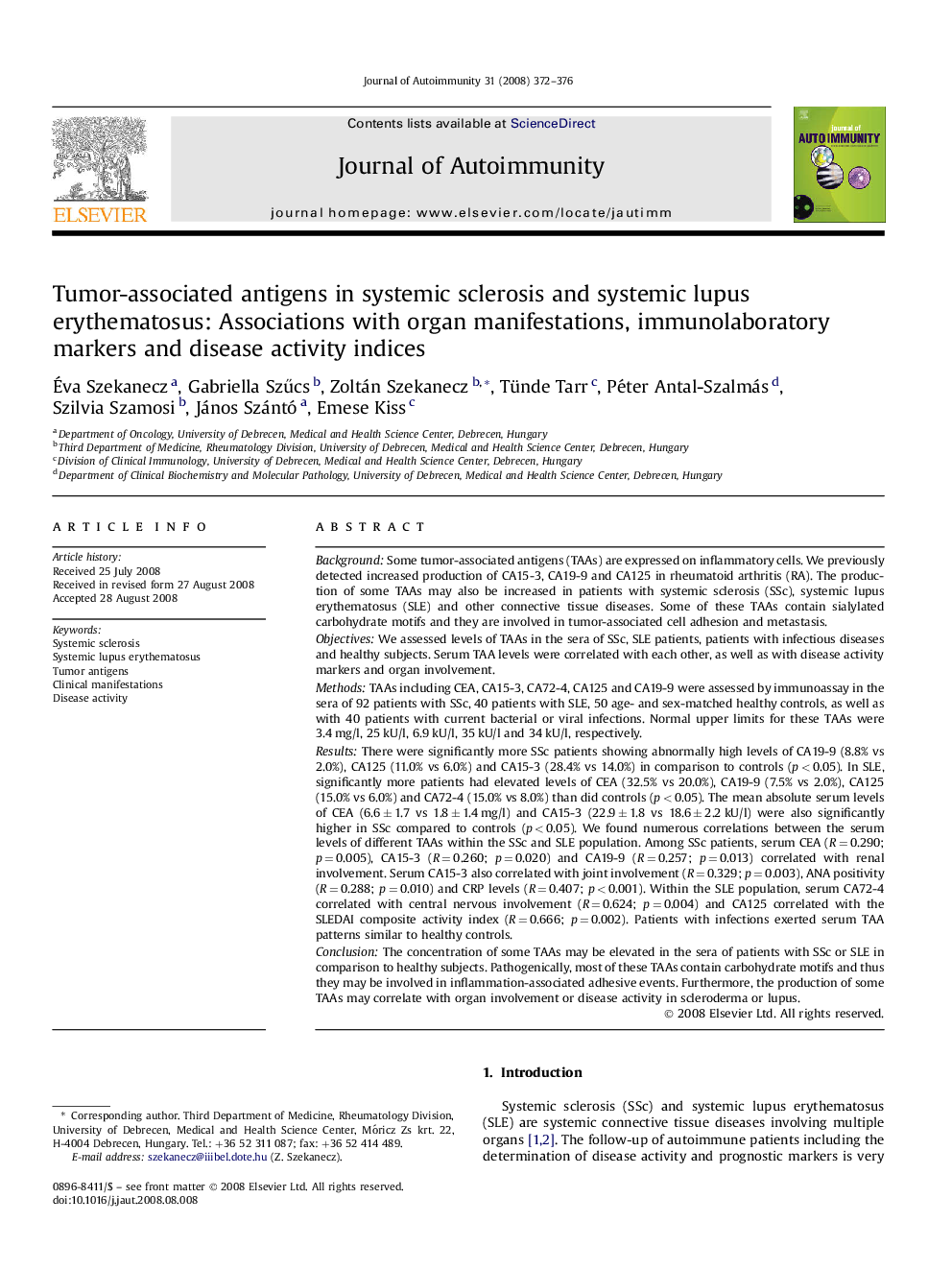| کد مقاله | کد نشریه | سال انتشار | مقاله انگلیسی | نسخه تمام متن |
|---|---|---|---|---|
| 3368141 | 1218772 | 2008 | 5 صفحه PDF | دانلود رایگان |

BackgroundSome tumor-associated antigens (TAAs) are expressed on inflammatory cells. We previously detected increased production of CA15-3, CA19-9 and CA125 in rheumatoid arthritis (RA). The production of some TAAs may also be increased in patients with systemic sclerosis (SSc), systemic lupus erythematosus (SLE) and other connective tissue diseases. Some of these TAAs contain sialylated carbohydrate motifs and they are involved in tumor-associated cell adhesion and metastasis.ObjectivesWe assessed levels of TAAs in the sera of SSc, SLE patients, patients with infectious diseases and healthy subjects. Serum TAA levels were correlated with each other, as well as with disease activity markers and organ involvement.MethodsTAAs including CEA, CA15-3, CA72-4, CA125 and CA19-9 were assessed by immunoassay in the sera of 92 patients with SSc, 40 patients with SLE, 50 age- and sex-matched healthy controls, as well as with 40 patients with current bacterial or viral infections. Normal upper limits for these TAAs were 3.4 mg/l, 25 kU/l, 6.9 kU/l, 35 kU/l and 34 kU/l, respectively.ResultsThere were significantly more SSc patients showing abnormally high levels of CA19-9 (8.8% vs 2.0%), CA125 (11.0% vs 6.0%) and CA15-3 (28.4% vs 14.0%) in comparison to controls (p < 0.05). In SLE, significantly more patients had elevated levels of CEA (32.5% vs 20.0%), CA19-9 (7.5% vs 2.0%), CA125 (15.0% vs 6.0%) and CA72-4 (15.0% vs 8.0%) than did controls (p < 0.05). The mean absolute serum levels of CEA (6.6 ± 1.7 vs 1.8 ± 1.4 mg/l) and CA15-3 (22.9 ± 1.8 vs 18.6 ± 2.2 kU/l) were also significantly higher in SSc compared to controls (p < 0.05). We found numerous correlations between the serum levels of different TAAs within the SSc and SLE population. Among SSc patients, serum CEA (R = 0.290; p = 0.005), CA15-3 (R = 0.260; p = 0.020) and CA19-9 (R = 0.257; p = 0.013) correlated with renal involvement. Serum CA15-3 also correlated with joint involvement (R = 0.329; p = 0.003), ANA positivity (R = 0.288; p = 0.010) and CRP levels (R = 0.407; p < 0.001). Within the SLE population, serum CA72-4 correlated with central nervous involvement (R = 0.624; p = 0.004) and CA125 correlated with the SLEDAI composite activity index (R = 0.666; p = 0.002). Patients with infections exerted serum TAA patterns similar to healthy controls.ConclusionThe concentration of some TAAs may be elevated in the sera of patients with SSc or SLE in comparison to healthy subjects. Pathogenically, most of these TAAs contain carbohydrate motifs and thus they may be involved in inflammation-associated adhesive events. Furthermore, the production of some TAAs may correlate with organ involvement or disease activity in scleroderma or lupus.
Journal: Journal of Autoimmunity - Volume 31, Issue 4, December 2008, Pages 372–376